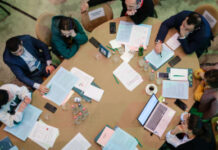 By Nancy Kalajian
By Nancy Kalajian
Special to the Mirror-Spectator
Dr. Susan Pattie, author of the newly-released paperback, Who are the Armenians?, has produced a contemporary, colorful and informative guide and accompanying CD to introduce Armenian history and culture. When she recently spoke about the book to a full house at NASSR in Belmont, Mass., nearly 50 copies of the book were sold that evening alone.
Aimed at children aged 5-12, the format and design of the book easily engages readers of all ages; there are 16 sections or mini chapters, and each section makes good use of background color, font color changes, captions and highlighted words, to share and distinguish related information.
Information is usually presented within a few paragraphs on each page, or occasionally on lists, for example, on traditional Armenian instruments or letters of the Armenian alphabet.
The readability level and font size might be a bit challenging for an early elementary age student, though the spacing between lines of print is generous, which can make it easier for younger readers to access.
For those youngsters who may have difficulty reading it on their own, an older sibling or adult could easily read it to a child who could follow along looking at the attractive visual information. Indeed, the wonderful family photographs, illustrations, friendly and simple captions and wealth of information will likely capture the interest of readers of all levels.









